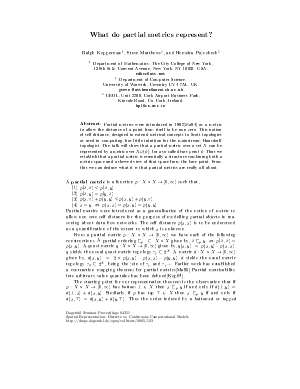What do partial metrics represent?
Authors Ralph Kopperman, Steve Matthews, Homeira Pajoohesh
-
Part of:
Volume:
Dagstuhl Seminar Proceedings, Volume 4351
Part of: Series: Dagstuhl Seminar Proceedings (DagSemProc) - License:
 Creative Commons Attribution 4.0 International license
Creative Commons Attribution 4.0 International license
- Publication Date: 2005-04-22
File

PDF
DagSemProc.04351.22.pdf
- Filesize: 160 kB
- 4 pages
Document Identifiers
Subject Classification
Keywords
- Metric
- partial metric
- base point
Metrics
- Access Statistics
-
Total Accesses (updated on a weekly basis)
0Document
0Metadata
Abstract
Partial metrics were introduced in 1992 as a metric to allow the distance of a point from itself to be non zero. This notion of self distance, designed to extend metrical concepts to Scott topologies as used in computing, has little intuition for the mainstream Hausdorff topologist. The talk will show that a partial metric over a set can be represented by a metric over that set with a so-called 'base point'. Thus we establish that a partial metric is essentially a structure combining both a metric space and a skewed view of that space from the base point. From this we can deduce what it is that partial metrics are really all about.
Cite As Get BibTex
Ralph Kopperman, Steve Matthews, and Homeira Pajoohesh. What do partial metrics represent?. In Spatial Representation: Discrete vs. Continuous Computational Models. Dagstuhl Seminar Proceedings, Volume 4351, pp. 1-4, Schloss Dagstuhl – Leibniz-Zentrum für Informatik (2005)
https://doi.org/10.4230/DagSemProc.04351.22
BibTex
@InProceedings{kopperman_et_al:DagSemProc.04351.22,
author = {Kopperman, Ralph and Matthews, Steve and Pajoohesh, Homeira},
title = {{What do partial metrics represent?}},
booktitle = {Spatial Representation: Discrete vs. Continuous Computational Models},
pages = {1--4},
series = {Dagstuhl Seminar Proceedings (DagSemProc)},
ISSN = {1862-4405},
year = {2005},
volume = {4351},
editor = {Ralph Kopperman and Michael B. Smyth and Dieter Spreen and Julian Webster},
publisher = {Schloss Dagstuhl -- Leibniz-Zentrum f{\"u}r Informatik},
address = {Dagstuhl, Germany},
URL = {https://drops.dagstuhl.de/entities/document/10.4230/DagSemProc.04351.22},
URN = {urn:nbn:de:0030-drops-1239},
doi = {10.4230/DagSemProc.04351.22},
annote = {Keywords: Metric , partial metric , base point}
}
